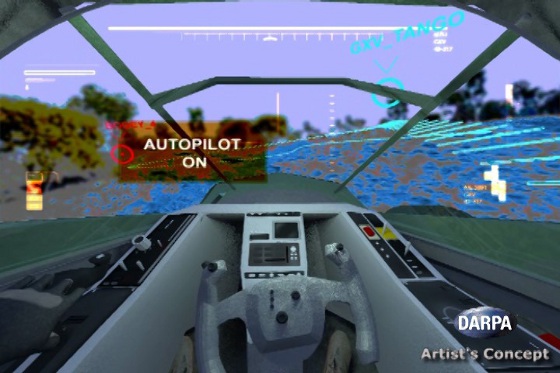 |
| July 17, 2018 | Volume 14 Issue 27 |
Designfax weekly eMagazine
Archives
Partners
Manufacturing Center
Product Spotlight
Modern Applications News
Metalworking Ideas For
Today's Job Shops
Tooling and Production
Strategies for large
metalworking plants
Wheels:
Future combat vehicles get super flexible -- Wow!

Editor's Note: Please watch the video. Very informative.
An evolving project from the Defense Advanced Research Projects Agency (DARPA) aims to improve the mobility, survivability, safety, and effectiveness of future U.S. military combat vehicles without piling on armor. Several Phase 2 contract awardees for the Ground X-Vehicle Technologies (GXV-T) program recently demonstrated advances on a variety of potentially groundbreaking technologies to meet the initiative's goals.
"We're looking at how to enhance survivability by buttoning up the cockpit and augmenting the crew through driver-assistance aids," said Maj. Amber Walker, the program manager for GXV-T in DARPA's Tactical Technology Office. "For mobility, we've taken a radically different approach by avoiding armor and developing options to move quickly and be agile over all terrain."

GXV-T's technical goals include the following improvements relative to today's armored fighting vehicles:
- Reduce vehicle size and weight by 50 percent;
- Reduce onboard crew needed to operate vehicle by 50 percent;
- Increase vehicle speed by 100 percent;
- Access 95 percent of terrain; and
- Reduce signatures that enable adversaries to detect and engage vehicles.
VIDEO: DARPA's Ground X-Vehicle Technologies (GXV-T) program aims to improve mobility, survivability, safety, and effectiveness of future combat vehicles without up-armoring the vehicle.
Demonstrations, such as one in May 2018 at Aberdeen Test Center in Maryland, have given potential military service transition partners an opportunity to observe technical progress on the GXV-T program, including radically enhanced mobility and crew augmentation.
Radically Enhanced Mobility
GXV-T envisions future combat vehicles that could traverse up to 95 percent of off-road terrain, including slopes and various elevations. Capabilities include revolutionary wheel-to-track and suspension technologies that would enable access and faster travel both on- and off-road, compared to existing ground vehicles. Standout technologies include:
- Reconfigurable Wheel-Track (RWT) -- Wheels permit fast travel on hard surfaces while tracks perform better on soft surfaces. A team from Carnegie Mellon University National Robotics Engineering Center (CMU NREC) demonstrated shape-shifting wheel-track mechanisms that transition from a round wheel to a triangular track and back again while the vehicle is on the move, providing instant improvements to tactical mobility and maneuverability on diverse terrains.
- Electric In-hub Motor -- Putting motors directly inside the wheels offers numerous potential benefits for combat vehicles, such as heightened acceleration and maneuverability with optimal torque, traction, power, and speed over rough or smooth terrain. In an earlier demonstration, QinetiQ demonstrated a unique approach, incorporating three gear stages and a complex thermal management design into a system small enough to fit a standard military 20-in. rim.
- Multi-mode Extreme Travel Suspension (METS) -- Pratt & Miller's METS system aims to enable high-speed travel over rough terrain while keeping the vehicle upright and minimizing occupant discomfort. The vehicle demonstrator incorporates standard military 20-in. wheels, advanced short-travel suspension of 4 to 6 in., and a novel high-travel suspension that extends up to 6 ft (42 in. upward and 30 in. downward). The demonstration in May showed off its ability to tackle steep slopes and grades by actively and independently adjusting the hydraulic suspension on each wheel of the vehicle.







Crew Augmentation
Traditional combat vehicle designs have small windows that improve protection but limit visibility. GXV-T sought solutions with multiple onboard sensors and technologies to provide high-resolution, 360-degree situational awareness while keeping the vehicle enclosed.

- Enhanced 360-degree Awareness with Virtual Windows -- Honeywell International demonstrated its windowless cockpit in an all-terrain vehicle (ATV) with an opaque canopy. The 3D near-to-eye goggles, optical head tracker, and wrap-around Active Window Display screens provide real-time, high-resolution views outside the vehicle. In off-road courses, drivers have completed numerous tests using the system in roughly the same time as drivers in All Terrain Vehicles (ATVs) with full visibility.
- Virtual Perspectives Augmenting Natural Experience (V-PANE) -- A tactical vehicle offers limited visibility and data for decision-making, especially when moving rapidly through unfamiliar territory. Raytheon BBN Technologies' V-PANE technology demonstrator fuses data from multiple vehicle-mounted video and LIDAR cameras to create a real-time 3D model of the vehicle and its nearby surroundings. In a final Phase 2 demonstration, drivers and commanders in a windowless recreational vehicle successfully switched among multiple virtual perspectives to accurately maneuver the vehicle and detect targets of interest during both low- and high-speed travel.
- Off-Road Crew Augmentation (ORCA) -- A second CMU NREC technology demonstration, ORCA aims to predict in real time the safest and fastest route and, when necessary, enable a vehicle to drive itself off-road -- even around obstacles. In Phase 2 testing, drivers using the ORCA aids and visual overlays traveled faster between waypoints and eliminated nearly all pauses to determine their routes. The team found autonomy improved either vehicle speed or risk posture -- and sometimes both.


Walker said GXV-T performers are pursuing a variety of transition paths for the new technologies.

Source: DARPA
Published July 2018
Rate this article
View our terms of use and privacy policy
